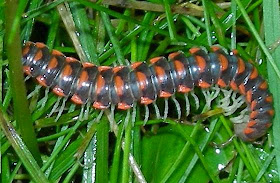-With apologies to Art Linkletter
On a Discover Nature field trip with Watkins Elementary students last week, we had the kids roll over a few decaying logs which reliably yields interesting critters. In this case they turned up this millipede.
 |
| Round-backed millipede |
 |
| Two pair of legs per segment = millipede |
 |
| Euryurus leachii - Steve Dunbar |
 |
| Jon Rapp |
I had previously found this same millipede. After reviewing many pictures on Bugguide.net, I finally called it millipede - genus Sigmoria or Autorusus. I sent photographs to Bugguide which is followed by lots of professional and citizen scientists who are knowledgeable and passionate about their niche in the insect world. In this case, within 24 hours we had an ID of Auturus evides, confirmation that it was known to occur in Missouri, and even photographs by our friend Jon Rapp from Columbia, Missouri.
There is no information online specific to the Auturus genus. They are members of the Euryuridae family which has 11 species in 2 genera. Rowland Shelly* is a frequently quoted expert in the field.
"They are one of the few millipedes with a precise habitat; I always find euryurids in association with decaying hardwood/deciduous logs or stumps (rarely pine) near water sources like streams, creeks, seepages. If no water nearby, then no euryurids." *Millipedes get little respect on the web. Even the order Polydesmida or flat-backed millipedes like ours above only gets three small paragraphs in Wikipedia. Fortunately they don't seem to take it personally. This is the order that contains all the cyanide producing millipedes. I don't know if our A. evides excretes cyanide but I wouldn't want to do a taste test and I take the precaution of telling the observers to never lick a millipede.
Millipedes are scavenger herbivores and lack the biting mouth parts that predatory centipedes have, meaning that they can be handled safely. They consume dead and decaying wood and leaves. Some have bright aposematic colors advertising their toxicity (or in the case of mimics, pretending they are toxic to scare off predators). Either way, I suggest that you never eat a millipede.
Update 3-29-2017
The BugLady's column "Bug of the Week" was filled with fascinating millipede details, the highlight of which is the lemurs that lick millipedes as an insecticide and a high!
* Rowland Shelly is Curator of Terrestrial Invertebrates at the North Carolina State Museum of Natural Sciences, Raleigh.
- More detailed information is on his web pages at this link.
- A more friendly and approachable version for us mere mortals is available as a pdf from this Emporia State University site.
